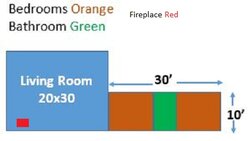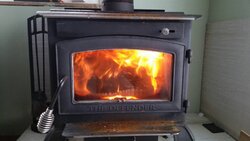So I bought a very lightly used stove in September of last year the original owner used it for 2 months for supplemental heat in his double wide while they waited to get enough money to replace their furnace. He doused it in wd40 to keep it from rusting. A little weird I know but I assembled the piping and burned a good fire in it to burn off the WD40 before installing it at the end of September. Unfortunately I wasn't able to fire the stove again after install until this weekend.
Now here is my concern. I know everything is installed correctly BUTTT I didn't get a chance to fire the stove in its new location. The outdoor temps are supposed to be around -1*F with 10-20 mph winds and am concerned with the stove heating the cottage. It is 960 sq. ft. and the stove is rated for 1200 sq. ft. and 68,000 BTU with hardwood. Do you think I will have a problem heating the space? The insulation is brand new in the walls R13 and in the R19 in the ceilings. Below is a layout of the cottage.
Now here is my concern. I know everything is installed correctly BUTTT I didn't get a chance to fire the stove in its new location. The outdoor temps are supposed to be around -1*F with 10-20 mph winds and am concerned with the stove heating the cottage. It is 960 sq. ft. and the stove is rated for 1200 sq. ft. and 68,000 BTU with hardwood. Do you think I will have a problem heating the space? The insulation is brand new in the walls R13 and in the R19 in the ceilings. Below is a layout of the cottage.




